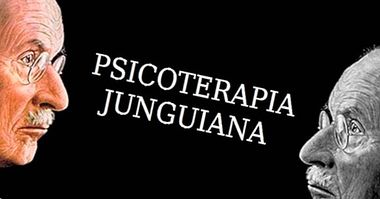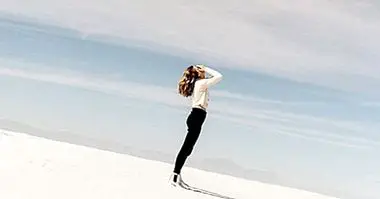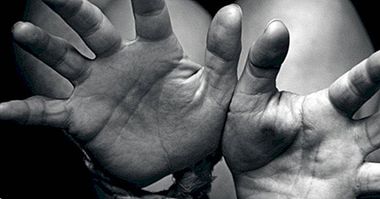Jacobson's Progressive Relaxation: use, phases and effects
In the last decade, the boom in the prescription of relaxation techniques in the field of clinical psychology and health is attributed to the palpable evidence of an acceleration in the rhythm of life that the human being has been incorporating as usual of daily operation.
This type of practice is intended to act not only as a type of intervention in the reduction of personal stress, but they become an effective alternative in the prevention of its appearance. Jacobson's Progressive Relaxation is one of the most used ; next we will see its characteristics, its phases and how it is carried out.
Fundamentals of relaxation techniques
Relaxation is considered as a response contrary to the tension or stress response.
In the stress response there is an activation of the sympathetic branch of the Autonomic Nervous System (ANS). The SNA is the part of the body that controls involuntary actions , such as heart and respiratory rate, contraction and dilation of blood vessels, digestion, salivation, sweat, etc.
The Antónomo Nervous System is divided into a sympathetic nervous system (which prepares the individual for action) and the parasympathetic nervous system (which performs opposite functions to the first as maintaining a body state of rest after an effort, decreasing the stress level of the body. organism).
Relaxation produces an activation of the parasympathetic branch of the SNA. Therefore, relaxation can be considered as a state of hypoactivation.
- Related article: "6 easy relaxation techniques to combat stress"
What is relaxation?
The definition that is granted from the psychology of emotions proposes to conceptualize relaxation as the physiological, subjective and behavioral state that is experienced during the occurrence of an intense emotion but of opposite sign (especially regarding unpleasant emotions such as anger, stress or aggressiveness). Therefore, relaxation allows to counteract the effects of physiological activation derived from this type of emotions, as well as becomes a very useful resource to reduce anxiety, fears or symptoms of depression.
Other benefits of relaxation consist of: improvement of blood flow, blood pressure and heart rate, optimization of brain wave function, regulation of breathing rhythm, promotes muscle distension, increasing the sense of calm and general vitality, enabling a higher level of attention. In short, relaxation has the ability to provide the organism with a general state of well-being, facilitating an adequate synchrony between the physiological and psychological functioning of the individual.
More specifically, relaxation has the following fundamental objectives: reduce or eliminate daily tensions, increase general well-being, promote self-knowledge, increase self-esteem, enhance the performance of the subject's activity, improve coping with disturbing situations or conflicts determined personal, and derived from it, opt for more satisfying interpersonal relationships.
General considerations of the procedures
In the first place, one aspect that should be taken into account when putting this type of technique into practice is the fact that we think that it is a set of learning that will be perfected as they are applied. The process requires a training phase that allows getting better results after the exercises, so the practice is an essential requirement to assess its effectiveness.
The time devoted to relaxation exercises ranges from 30-40 minutes per day during the first two weeks to subsequently reduce the duration of the activity to about 10 minutes or by spacing it every other day, for example.
When putting the training into practice, it must be taken into account that relaxation must be carried out as a priority in a quiet and quiet room , far from interruptions, and with pleasant temperature and moderate light (although it is not exclusive). In addition, it is recommended that the person wear comfortable and loose clothing.
Effects of these techniques
When the goal of relaxation is to calm the high physiological activation in an intense anxiety situation, we resort to shorter relaxation procedures adapted to the specific type of situation. When the purpose is to lower the level of general activation, it is recommended to perform the most extensive exercise in terms of time in a calm environment free of environmental stimulation.
As the training phase is completed, the individual increases your perception of self-efficacy in the control of stressful situations and in maintaining a relaxed general state of well-being, decreasing the likelihood that new episodes of increased levels of anxiety may occur.
The training also allows greater self-control of disturbing thoughts , since as indicated above, the physiological and psychological state are closely related to each other. Usually, relaxation techniques are applied as a component of a more complete psychological intervention where the emotional, cognitive and behavioral areas are worked more deeply.
On the other hand, it should be noted that depending on the individual, the practice of relaxation can cause him to experience new sensations not familiar to him. Given that it is a totally habitual aspect, it is only recommended that the person knows the type of reactions that may take place previously and the reason for which they occur. Some of these sensations may consist of: heaviness of a part of the body or otherwise, feeling of lightness; feeling of concussion in the extremities; as well as tingling, feeling of immobility or abandonment of the body, etc.
Jacobson's Progressive Relaxation
This technique was developed in 1929 and today is one of the most used. Consists in learn to tense and relax the different muscle groups of the body .
Jacobson's Progressive Relaxation is based on the fact that the stress response generates a series of thoughts and behaviors that cause muscle tension in the person . This tension increases the subjective perception of anxiety. Progressive relaxation reduces this muscle tension, and with this the feeling of anxiety.
At the procedural level, the training is carried out over a minimum of seven weeks. During this period, the user will have to learn to tense and relax 16 muscle groups throughout the body: hands, forearms, biceps, shoulders, forehead, eyes, jaw, throat, lips, neck, neck, back, chest, abdomen, legs (thighs and calves).
The tension phase is performed for the user learn to perceive the sensations associated with the onset of anxiety or tension, being these sensations those that will indicate to the person who has to relax. This muscular tension allows the muscles to relax even more than if they had relaxed before tightening. At the end of the training, you will learn to relax the muscles directly without first putting them into tension.
Phases
In Jacobson's Progressive Relaxation usually the following phases are followed :
- During the first two weeks, you will practice stretching each day and then relaxing the 16 muscle groups.
- In the third week, the time to relax is reduced.
- During the fourth week, you learn to relax directly without putting your muscles previously in tension.
- In the fifth and sixth week you learn to be relaxed while doing various activities while sitting and also while standing and walking.
- In the last week, rapid relaxation is practiced many times a day in non-stressful situations.
- Finally, we begin to apply relaxation in anxiety-provoking situations starting with those situations that cause less anxiety. Once you manage to reduce anxiety in this situation, you move on to the next one.
Realization
More specifically, in each tension-distension exercise the user must tighten a group of muscles for about five or eight seconds . Subsequently, focus attention on the sensation that is experiencing this muscle tension. After these seconds, the person will relax this group of muscles for ten or fifteen seconds, then concentrate on the sensations experienced in the relaxed area.
Regarding the posture to be maintained during the activity , this can be done in three different positions:
- Sitting in an armchair, with his head supported, as well as his back and feet resting on the floor. The arms are relaxed on the thighs.
- Lying on a hard surface, to have supported the whole body and the head slightly raised.
- Position of the coachman, sitting on a chair, with the body leaning forward, head resting on the chest and arms on the legs.
Application of Jacobson's Progressive Relaxation
Jacobson's Progressive Relaxation focuses on teaching the person who practices it to distinguish between the sensation of tension and distension in the different parts of the body in which the training is distributed, in total 16 muscle groups.
From that moment, the subject will be able to optimally control what daily situations cause each of the tension-distension sensations and how to proceed to relieve the muscle groups in case of noticing an excess of tension. Tense situations usually, when relating to less pleasant emotions, they are decreasing with training , so that the state of emotional and psychological well-being of the individual tends to increase progressively.
Example
As exemplification of the application instructions, the following formulas can be used:
In a comfortable, quiet place with little distracting stimulation, introduces calm-inducing phrases such as "You are comfortable and relaxed, you can hear your breathing, you can not hear noise only silence ...". Subsequently, starting to work the first muscle group, the following instructions are followed:
1. Direct attention to the right arm , to the right hand in particular, close it, pull it tightly, and observe the tension that occurs in the hand, and in the forearm (for about 5 or 8 seconds).
2. Stop doing strength , relax your hand and let it rest where you have it supported. Observe the difference between tension and relaxation (10-15 seconds).
3. Close your right fist hard again and feel the tension in the hand and forearm, observe it carefully (10-15 seconds).
4. And now it loosens the muscles and stops strength allowing the fingers to relax relaxed. Note once again the difference between muscle tension and relaxation (10-15 seconds).
And so on with the rest of the muscle groups: hands, forearms, biceps, shoulders, forehead, eyes, jaw, throat, lips, neck, neck, back, chest, abdomen, legs (thighs and calves).
In short, training in Jacobson's Progressive Relaxation requires, as has been observed, the systematic, structured and well-sequenced application of the set of procedures that have been exposed in order to achieve an adequate level of effectiveness. It is understood, therefore, that it is the practice maintained over time that will allow further improvement in its implementation, so that these types of exercises are internalized as a new daily habit every day.
Bibliographic references:
- Caution JR, Groden J. Relaxation techniques (1985. Practical handbook for adults, children and special education). Barcelona: Martinez Roca.
- Olivares, J. and Méndez, F. X. (2008). Behavior modification techniques. Madrid: New library.



















